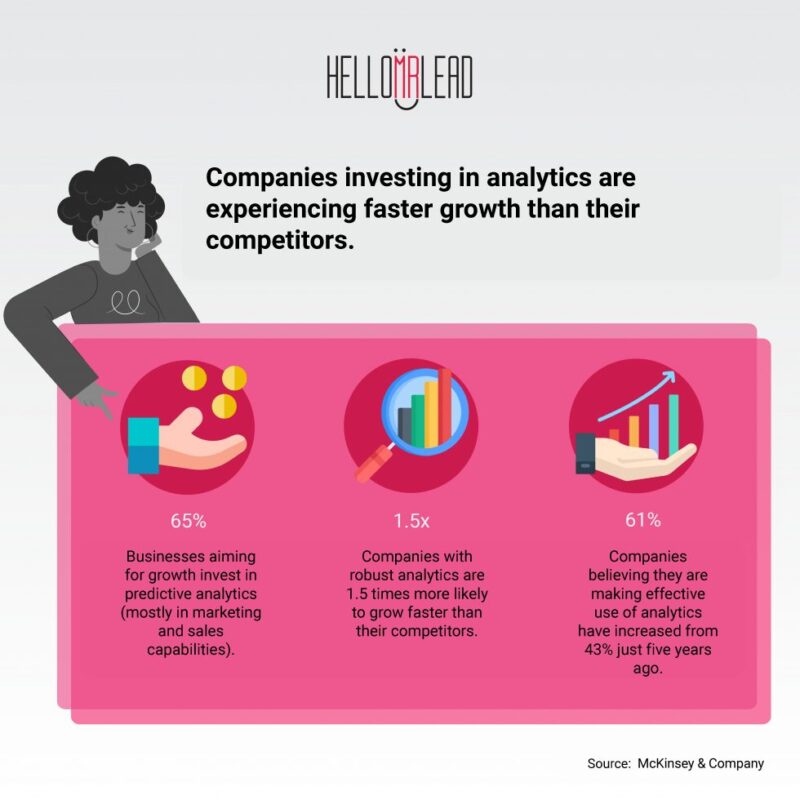Do you want to attract new leads to your company? Learn how to attract new leads through business analytics.
INDEX
1. DATA TO MEASURE
A. Business performance.
B. Sales targets.
C. Sales activities.
2. PROFITABILITY CALCULATION.
3. BEHAVIORS LINKED TO SUCCESS.
A. Consensus
B. Analytical talent
C. Data tools
D. Change management
I’m sure you think that the fast and efficient growth of a company is a myth, and you are partly right because, as in everything, hard work and perseverance are necessary.
But, if your company is a B2B and you want to grow faster, this article on business analytics is of interest to you.
Research conducted by McKinsey & Company has shown that thanks to business analytics implemented through technology in companies, they manage to grow 1.5% faster.

Statistics on data analysis in companies to attract new leads
But, this is not as easy as just betting on business analytics and starting to grow, there are numerous obstacles standing in the way.
The rise of B2C is cornering the B2B space, this means that companies with strong capabilities in eCommerce analytics have invaded B2B sectors.
According to this study conducted by McKinsey, 64% of B2B respondents agreed on the need to rely on business analytics for success.
For the implementation of this procedure in your corporation it is important to take into account several elements:
- Identify company objectives.
- Interpretation of the data.
- Translation of that information into strategies.
Once the company identifies its objectives and focuses all its departments on achieving them, it is essential to interpret the data and apply these results to the product or service.
This is the importance of knowing data about our customers and their needs, since we can use this information to sell more effectively.
1. Data to measure to know your company and get leads.
To determine the objectives of the sales team it is very important to be clear about the actions we are going to perform, so we can divide the most relevant metrics for this department into three sections:
a. Business results
This type of metrics serves to check the state of the company, so we can evaluate the current state of the business in relation to the competition.
This element is responsible for showing what the organization is doing, checking its development by means of the following KPIs:
- Revenue growth.
- Market share.
- Gross profit.
- Customer satisfaction rating.
b. Sales targets
This element is very useful for employees as they can orient themselves and see where they should focus, for example, after determining a main objective the workers will do their best to improve in that area.
To compare this type of metrics we can look at the following KPIs:
- Customer retention.
- % of new customers.
- No. of days of preparation of new salespeople.
- % of target audience contacted.
c. Sales activities
This type of metrics is mainly focused on quantifying the activities of the workers, i.e. the daily tasks of the salespeople.
These are the only metrics that we can translate into employee effort, some of the KPIs we consult in this case are:
- Number of sales made per worker.
- % of employees using CRM.
- % of account plans completed.
- Accounts assigned per employee.
- Number of employees assigned per manager.
- Money spent on learning for each employee.
Do you need a personalized consultancy? Purchase our service by clicking here.
2. Profitability calculation
To be aware of the profitability of each employee it is important to take into account several data:
- Turnover per employee.
- Net turnover/number of employees.
- Profit per employee.
- Net profit/no. of employees.
- Cost per employee.
- Social cost of the year/no. of employees with salary.
- Profit/cost ratio.
- Divide the second element by the third.
Once we have this information we must compare the data and study the results, in this way, we will know the productivity of each employee and the advantages and disadvantages of each element.
Do you need a personalized consultancy? Purchase our service by clicking here.
3. Behaviors linked to success
a. Consensus
This is the first step for growth. Once we have decided to implement business analytics, we must agree among the teams what is the greatest business value and focus all efforts in those areas.
It is natural that not all business analytics tools will fit your business, so it is important to experiment until you find the right one to increase growth and reduce failures.
The early identification of problems can help the company not to suffer an irreparable fall, so the business analytics tool can encourage rapid and positive changes in different areas of the company.
b. Analytical Talent
It is natural for companies to look for the best workers, this will make the business grow, but which are the best analytical talents?
This sector is one of the most studied because thanks to the information obtained we can improve our company and meet the needs of consumers.
Scientists and engineers are 10 to 50 times more productive than business analytics workers, so it is important to consider them in the recruitment process.
The creation of a data department is of great importance in companies and must start with a leader in analytics, complemented by analytical scientists, engineers and translators.
c. Data tools
The implementation of tools, algorithms and data architecture will depend on the size and stage of your company.
If you are just starting up your data analysis tools, you will not yet have a lot of information and you will not have been able to implement many changes.
However, if you already have a tool implemented in your business, you will be able to visualize the errors to be solved, the elements to be encouraged and the objectives you want to achieve.
Today there are applications that help us to obtain a lot of information to make changes in our strategy or even set new goals, some of them are:
- Power BI
- Good Data
- Looker
- Zoho Analytics
- Google Analytics
d. Change management
Once we have the analytics tool implemented we must give access to the sales teams so that they can adapt to the changes from the first moment.
This process should be a team effort by both the data department and the sales team, thanks to this relationship they will have information about customer needs.
When this relationship is established, the data department leaders should use the data obtained to model the thinking of the sales force.
Ultimately, once data tools are in place it is paramount that analysts focus on obtaining useful data for the business that can benefit them in creating new products, developing growth and solving problems.
The implementation of data tools will help you improve and get closer and closer to your customer, if you don’t have any of them yet, don’t hesitate to try them until you find the right one.





